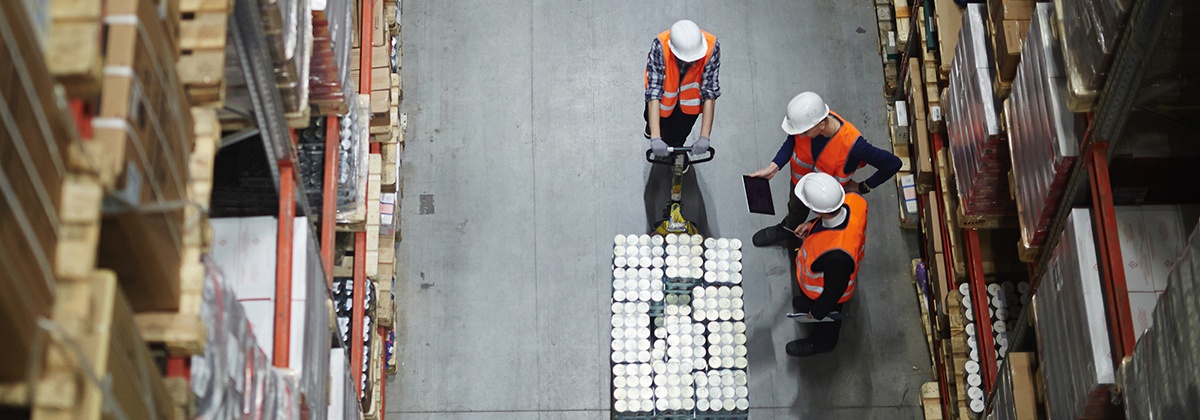

In today’s offices, facilities and factory floors, there are seemingly endless ways for people to communicate, from email to instant messaging, from texting to calling on landlines and cell phones.
No wonder team communications are so fragmented.
With all of these disparate tools being used, there’s just one wireless solution that lets teams cut across the noise—so to speak—and allows workers across departments and devices to keep in touch instantly, securely and safely: two-way radios.
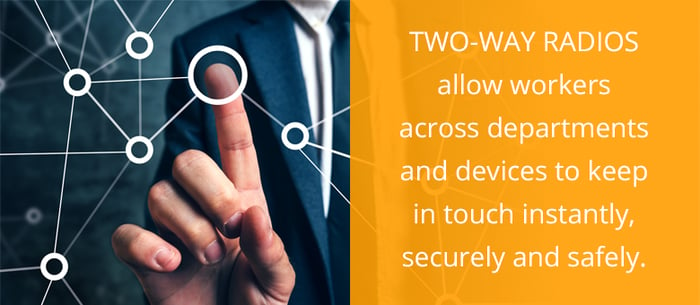
From hospitality to healthcare, manufacturing to transportation, two-way radios—along with applications and accessories—transform team communications and elevate collaboration to a high level that cell phones and landlines just can’t reach.
Radios help companies realize increased productivity, reduced downtime and enhanced worker safety, all for a lower total cost than smartphones. Breaking down departmental silos has never been faster and the dream of a truly unified workforce closer to reality.
Consider the impact of inefficient communications:
Unlike consumer cell phones, two-way radios are built and designed with business and industry users in mind to save time and peace of mind. This guide to Connecting Devices Across Departments makes the case for two-way radios over cell phones and landlines with a focus on:

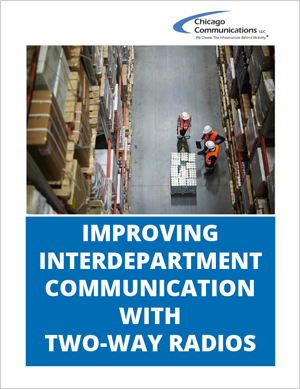
The speed of work today requires communications solutions that can keep up, especially when it comes to connecting across departments, teams, and geographies. For truly unified communications, cell phones and landlines are no longer the answer. In a head-to-head comparison, two-way radios will always win with:
Whether it’s related to a daily activity or a dire emergency, having to dial a number on a cell phone or landline is a waste of precious time. Push-to-Talk gives radio users instant communication, and with solutions for every situation, they can connect whether they’re in an office or outdoors. During serious incidents or situations, the ability to be in contact with the touch of a button means saving more than time.
The convenience of push-to-talk isn’t just for one-on-one communications; it’s for group calls, as well. Setting up radio channels for different groups enables users to reach every member of a team or department simultaneously.
Cell phones, on the other hand, can’t make multi-person calls. And time-consuming conference calls on landlines aren’t always possible or appropriate.
Thanks to platforms like Motorola’s WAVE Work Group Communications, push-to-talk is also no longer limited to two-way radios. WAVE enables push-to-talk for any device that communicates with radios, including cell phones, desktop computers, landlines, laptops, and tablets.
Connecting devices across departments has never been easier or more seamless.
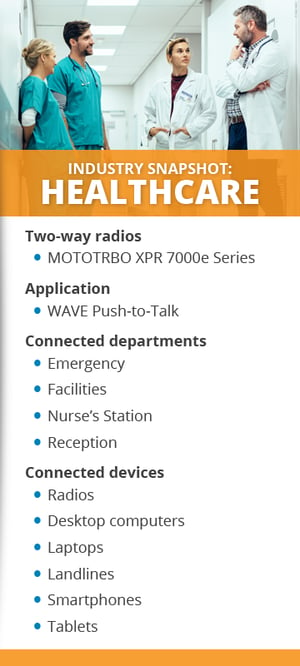 Reliable Reach
Reliable ReachCell phone connections are only as good as the network they’re on. While service in urban areas is generally guaranteed, coverage for rural users is less reliable, leaving those team members or departments out of critical conversations and decisions.
Landlines offer an even more frustrating dilemma—if the person is away from the office, it can take multiple calls to reach them. And not every area of a facility or building can be wired for landlines.
Radios offer an always-ready reach without limitations. There are no cell phone networks to rely on, and radios are light and discreet enough to travel with workers wherever they go, from the front desk to the basement.
With GPS tracking enabled on radios, teams always have access to real-time location information for people, deliveries, or supplies. The closest team member to a situation can be dispatched immediately, saving valuable time. And it cuts down on the number of times every day when staff have to ask, “What’s your 20*?”
*”Your 20” is two-way radio lingo for your location.
Plants and construction sites are noisy environments, and landlines and cell phones are often overwhelmed by the background noise generated by heavy equipment and machinery. Radios, on the other hand, employ noise-canceling technology to ensure every word is heard every time when voice communications are necessary.
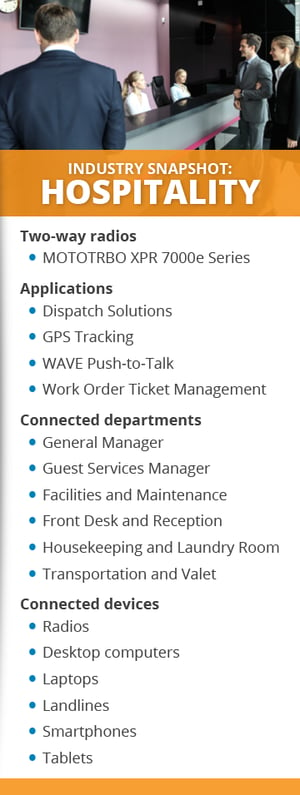
Headsets, remote speaker microphones, and earpieces are just some of the accessories that make radios customizable across departments and teams. Staff can grab radios and go, knowing that they’ll be able to tailor the functionality they need for their jobs, no matter where their work takes them.
The U.S. Department of Transportation approves the use of mobile radios while driving, which can’t be said for cell phones. Drivers don’t have to be out of touch just because they’re out on the road, making coordinating with them easy. Changes in directions or instructions can be delivered at any time, increasing efficiency and reducing downtime.
Even after a smartphone is paid for, there are ongoing monthly usage fees to pay. With radios, the price of the device and its accessories make up the total cost. Radio fleets can be gradually scaled and upgraded with no impact on service costs. Savings are something every department can get behind.
For businesses and industries that never take a day off, fully charged devices need to be readily available at all times, especially when they’re being shared across teams. Radio batteries can last long enough to power two full-time shifts, a feat unmatched by cell phone batteries.
With their use by first responders, public safety agencies, and the military, two-way radios are literally battle-tested. They’re designed to withstand temperature extremes, harsh conditions, and even water immersion. That makes them the ideal communications method for use across departments, where the workers may differ, but the need for durability remains the same.
Like smartphones, digital two-way radios have numerous applications, enabling them to handle both voice and data, including text messages, emails, and automatic alerts and work orders. However, unlike smartphones, they provide workers with the opportunity to focus on tasks at hand without the distractions of social media, games, and the latest must-watch videos.
Headsets and other accessories allow for a different kind of focus for maintenance and facility staff who need their hands free to complete their work.
Protecting property and information is becoming increasingly important and challenging, and radios play a crucial role in enhancing security and facilitating collaboration.
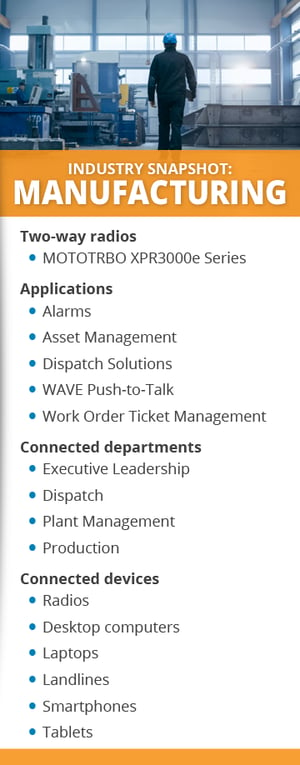
The security benefits of connecting devices across departments apply to both humans and machines. When a piece of equipment or machinery malfunctions, the alert can come from a colleague or the machine itself. The more people who are made aware immediately, the better the chances of minimizing the damage and danger.
For other alarms, the instant one-to-many capabilities of radios ensure that all relevant personnel are notified in real-time. Responses can be planned, coordinated, and executed within the time it takes for one cell phone or landline call. Multiple steps are consolidated into a single one, streamlining the security process.
Radios also enhance security by ensuring interoperability with police or fire departments, reducing response times, and facilitating easier coordination. Emergencies that overload cell phone towers or knock out landlines leave radio communications intact.
While collaboration across departments is vital, an increase in connections can also lead to an increased vulnerability to security breaches. The more users you have, the greater the chances that someone will let their guard down. But radios have a track record of security so strong that they’re trusted by fire, police, and military the world over.
In industries where the work is dangerous or remote, team communications have an additional responsibility: keeping everyone safe.
Two-way radios are equipped with sophisticated safety features that can protect employees even when they are unable to call for help themselves.
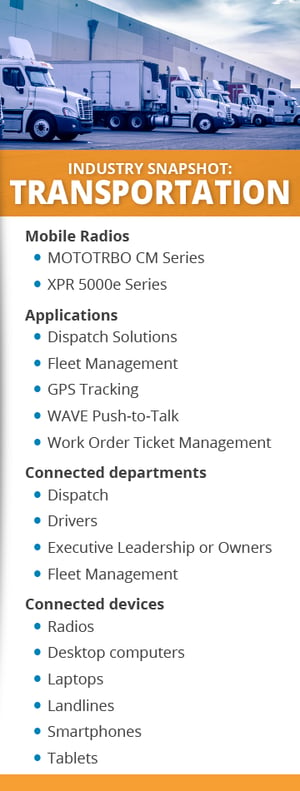
Also known as a “panic button,” an emergency button feature enables workers to call for help with a single touch. As with alarms, the call goes out to all relevant users, making it faster and easier to coordinate the response.
On the Motorola MOTOTRBO, Lone Worker is a safety feature that’s activated by a lack of user interaction. If the worker doesn’t touch the radio for a preset amount of time, a pre-warning tone sounds, signaling that it’s time to reset the timer. If the worker still doesn’t interact with the radio, an emergency call is placed.
The Man Down application is for workers who may become incapacitated. Radios are set to automatically alert if they’re tilted at a precarious angle for a prolonged period of time or if no movement is detected. If the worker is fine, they reposition the radio or disable the alert. If they don’t disable the alert, the emergency signal lets other users know to send help.
The problem of connecting devices across departments in growing companies has a cost-effective solution in two-way radios. Modern radios provide immediacy, security, and safety, rendering outdated landlines and consumer-focused cell phones obsolete.
The right suite of applications and accessories creates a unified communications solution that’s scalable and affordable. For a two-way radio solution tailored to your business's needs, enlist the help of an experienced channel partner.
